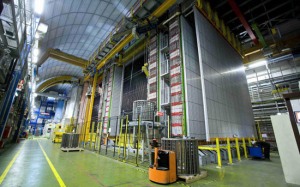In 1983, Ohio State University historian Stephen Kern wrote The Culture of Time and Space, 1880-1918, a book which talked about the sweeping changes in technology and culture that reshaped life, including the theory of relativity and introduction of Sir Sandford Fleming’s worldwide Standard Time – and an onrush of technics, including telephone, electric lighting, steamships, skyscrapers, bicycles, cinema, airplanes, X-rays, machine guns, as well as cultural innovations that shattered older forms of art and thought, such as the stream-of-consciousness novel, psychoanalysis, Cubism, simultaneous poetry. All of these things created new ways of understanding and experiencing time and space during that almost 40-year period ending with the end of the First World War. Kern’s argument is that in the modern preoccupation with speed, especially with the fast and impersonal telegraph, international diplomacy broke down in July 1914, leading to the outbreak of the First World War the following month.
In physics, according to Albert Einstein’s 1905 theory of special relativity (SR), motion in space alters the flow of time, creating a time dilation, speeding up or slowing down time, because as you move through space, time itself is measured differently for the moving object than the unmoving object. This, in theory, would allow time travel within the known laws of physics into the future, not into the past.
I had a very odd experience, more akin to what Kern wrote about 33 years ago than Einsteinian physics, I suppose, where time was a product of perception – in this instance slowing down, rather than speeding up – back on Feb. 9, 2015, when I began working as a library clerk on the new Thompson campus of University College of the North (UCN) at the intersection of Thompson Drive North and UCN Drive.
I decided, probably not wisely in retrospect, to bicycle to work my first night, taking the then newly paved but snow-covered two-lane multi-use boulevard pathway for pedestrians and cyclists that then ran pretty much from behind my house all the way down to UCN (it now runs even further to Cree Road). While I had been riding all winter, very little of it until that point had been on the multi-use boulevard pathway toward UCN. I was also using an unfamiliar bicycle with some chain-dropping problems that first night.
The result was too little time and heavy exertion, not wanting to be late for work my first night. I thought I had given myself plenty of time for my 6:30 p.m. start, but conditions were more adverse than I anticipated. The ride is two kilometres, the last half kilometre or so from about the Giant Tiger department store to campus.
I distinctly remember checking the wristwatch on my left wrist four of five times under street lights as I pushed as hard as I could that last half-kilometre stretch. The oddest thing was the first three or four times, the hands on the analog display showed 6:28 p.m. – as if time was standing still, although my bicycle was in motion with me aboard. It wasn’t until I got to the door at UCN, the watch seemed to move that last two minutes to show exactly 6:30 p.m. on the dot. I have no rational explanation for what happened. Did the minute hand on my watch get stuck briefly and then free itself and jump ahead the two minutes? Maybe, but it didn’t feel like that.
Speaking of rational, under Manitoba’s Official Time Act, Daylight Saving Time (DST) begins on the second Sunday in March and continues until the first Sunday in November. That means it begins tomorrow. How rational Daylight Saving Time is; well that continues to be a matter of some debate.
The official time change to Daylight Saving Time occurs at 2 a.m., Sunday, March 13, at which time clocks should be set ahead to 3 a.m.
While it has been gradually remaining lighter later in the evening since late December here in the Northern Hemisphere, we’re about to get an even bigger early evening light boost Sunday. Tonight the sun sets here in Thompson, Manitoba at Latitude 56° 19.8′ North at 6:31 p.m. Central Standard Time (CST), according to National Research Council (NRC) of Canada calculations. Tomorrow sunset here is at 7:33 p.m. Central Daylight Saving Time (CDT). Presto! In the course of a single day, we’ve picked up another hour and two minutes of daylight in the evening. And by the time the spring equinox arrives March 20 here in Thompson, we’ll be seeing about the same amount of hours of daylight as night, with sunrise at 7:33 a.m., and sunset at 7:48 p.m. Come the summer solstice June 20, don’t be surprised if we’re out on the dock at the Paint Lake Marina, a bit south of here, fishing until almost 11 p.m., as sunset won’t be until 10:26 p.m., while the end of civil twilight, defined as the centre of the sun’s disk at six degrees below the horizon, and the limit at which illumination is sufficient, under good weather conditions, for terrestrial objects to be clearly distinguished; the horizon is clearly defined and the brightest stars are visible under good atmospheric conditions, won’t be for more than an hour later at 11:30 p.m. CDT.
While fishing until midnight on the dock sounds pretty appealing right about now, as Lucas Powers pointed out earlier today in an interesting online CBC News story headlined “Daylight saving time 2016: How big business benefits from more sunshine. Longer daylight time has nothing to do with saving energy or benefiting farmers, critics say, which you can read at http://www.cbc.ca/news/business/daylight-saving-business-energy-1.3485281, as it outlines how the biggest long-time (pardon the pun) advocates for Daylight Saving Time over the years has been no other than the big business lobby. Tufts University professor Michael Downing wrote a book, Spring Forward: The Annual Madness of Daylight Saving Time, on the phenomena 10 years ago.
The Alexandria, Virginia-based Association for Convenience & Petroleum Retailing, formerly known as the National Association of Convenience Stores, founded in August 1961, loves Daylight Saving Time. Likewise big-box stores, sporting and recreational goods manufacturers, barbecue and charcoal retailers, lawn and garden retailers, shopping malls and golf courses. Surprise.
For this, we can thank (or blame) George Vernon Hudson, an English-born New Zealand amateur entomologist and astronomer who gave the world Daylight Saving Time (DST). Hudson’s day (and sometimes night) job was as a clerk (eventually chief clerk) in the post office in the capital of Wellington on North Island, and, in all fairness, Hudson could hardly be accused of being a shill for big business. They just picked up on Hudson’s idea in time, so to speak, and ran with it.
Standard Time, of course, with its standardized times zones, is a Canadian invention, courtesy of Sir Sanford Fleming, conveniently divided into hourly segments, and dating back to October 1884 and the International Prime Meridian Conference attended by 25 nations in Washington, D.C. Before Fleming invented standard time, noon in Kingston, Ontario was 12 minutes later than noon in Montréal and 13 minutes before noon in Toronto. Noon local time was the time when the sun stood exactly overhead.
Most of Canada’s time experts work in a place called Building M-36 (which involuntarily conjures up for me visions of the X-Files and Area 51.) They work in the Frequency and Time program in the Measurement Science and Standards portfolio with the National Research Council of Canada on Montreal Road in Ottawa. Physicist Rob Douglas, a principal research officer in the Frequency and Time group, however, can be found on Saskatchewan Drive in Edmonton.
Fleming’s genius was to create 24 time zones and within each zone the clocks would indicate the same time, with a one-hour difference between adjoining zones. Usually, when one travels in an easterly direction, a different time zone is crossed every 15 degrees of longitude, which is equal to one hour in time.
But on the other side of the world in New Zealand, Hudson had a somewhat different interest a decade or so after Fleming’s development of Standard Time. Hudson’s shift-work job gave him enough leisure time to collect insects, and led him to value after-work hours of daylight for that pursuit when he was working days. On Oct.15, 1895, spring in New Zealand, he presented a paper called “On Seasonal Time-adjustment in Countries South of Lat. 30°” to the Wellington Philosophical Society, proposing a two-hour daylight-saving shift, and after considerable interest was expressed in Christchurch on South Island, where 1,000 copies of his paper were printed in 1896, he followed up on Oct. 8, 1898 with a second paper, “On Seasonal Time,” also presented to the Wellington Philosophical Society in springtime, and which can be found in the Transactions and Proceedings of the Royal Society of New Zealand, housed at the National Library of New Zealand in Wellington.
While interest grew in Hudson’s Daylight Saving Time ideas between 1895 and 1898, they were hardly greeted by a rousing show of unanimous support when he presented his first paper in Wellington on Oct. 15, 1895, according to the abstract in Volume 28, 1895 of the Transactions and Proceedings of the Royal Society of New Zealand, which noted, “The author proposed to alter the time of the clock at the equinoxes so as to bring the working-hours of the day within the period of daylight, and by utilizing the early morning, so reduce the excessive use of artificial light which at present prevails.
“Mr. Travers said the clocks could be managed by having different hands. He did not think we were far enough advanced to adopt the plan advocated by the author of the paper.
“Mr. Harding said that the only practical part of Mr. Hudson’s paper had long since been anticipated by Benjamin Franklin, one of whose essays denounced the extravagance of making up for lost daylight by artificial light. Mr. Hudson’s original suggestions were wholly unscientific and impracticable. If he really had found many to support his views, they should unite and agitate for a reform.
“Mr. Maskell said that the mere calling the hours different would not make any difference in the time. It was out of the question to think of altering a system that had been in use for thousands of years, and found by experience to be the best. The paper was not practical.
“Mr. Hawthorne did not see any difficulty in carrying out the views advocated so ably by Mr. Hudson.
“Mr. Hustwick was of opinion that the reform spoken of would have to wait a little longer.
“Mr. Richardson said that it would be a good thing if the plan could be applied to the young people.
“Mr. Hudson, in reply, said that he was sorry to see the paper treated rather with ridicule. He intended it to be practical. It was approved of by those much in the open air. There would be no difficulty in altering the clocks.”
While Hudson may he have been somewhat discouraged by that initial reception, he was far from defeated, so he was back before the Wellington Philosophical Society with his second paper on the subject three years later in October 1898:
“In order to more fully utilize the long days of summer, it is proposed on the 1st October of each year to put the standard time on two hours by making 12 (midnight) into 2 a.m., whilst on the 1st March the time would be put back two hours by making 2 a.m. into 12 (midnight), thus reverting to the present time arrangements for the winter months,” wrote Hudson in 1898.
“The effect of this alteration would be to advance all the day’s operations in summer two hours compared with the present system. In this way the early-morning daylight would be utilised, and a long period of daylight leisure would be made available in the evening for cricket, gardening, cycling, or any other outdoor pursuit desired. It will no doubt be urged that people are at present quite at liberty to make use of the early-morning daylight in summer without any such drastic alteration in the established order of things as is here suggested. To this objection it may be pointed out that, living as we do in a social community, we are unable to separate ourselves from the habits of those around us. We cannot individually alter our times of going to bed or getting up, but must fall in with the habits of the majority – at all events, to a great extent, Again, under the present arrangement, those who desire to utilise the early-morning daylight are compelled to take some of their recreation before their daily work and some afterwards, which in many cases results in their having to forgo pursuits that they would be enabled to follow successfully if their daylight leisure were continuous … The foregoing remarks are framed to apply to us in the Southern Hemisphere, but with the seasons reversed they’ would, of course, apply with equal force to the Northern; Hemisphere.”
While Vernon’s self interest in Daylight Saving Time stemmed at least in part from his interest in collecting insects during a longer evening, along with such other genteel pursuits by his countrymen as cricket, gardening and cycling, it wouldn’t be until 18 years later that his DST proposals would be implemented in a modified form in a very different military context in the midst of the First World War by Germany and Austria at 11 p.m. on April 30, 1916, when they advanced the hands of the clock one hour until the following October. The rationale was simple: conserve fuel needed to produce electric power. Belgium, Denmark, France, Italy, Luxembourg, Netherlands, Norway, Portugal, Sweden, Turkey and Tasmania immediately followed suit, as did Manitoba and Nova Scotia here in Canada. Britain also followed three weeks later on May 21, 1916. In 1917, Australia and Newfoundland began DST.
The United States followed on March 31, 1918 and Daylight Saving Time was observed for seven months in 1918 and 1919, but was largely unpopular and Americans used in variably and inconsistently for decades afterwards. The most recent change in the United States, pursuant to the Energy Policy Act of 2005, adding parts of March and November to DST, came into effect in 2007, and has been adopted by most Canadian jurisdictions to keep in synchronization with American business and government interests. The operative word is “most,” however, as there are a slew of Canadian exceptions to the general norm.
Most of British Columbia is on Pacific Time and observes DST, but there are two main exceptions: Part of the Peace River Regional District, including the communities of Chetwynd, Dawson Creek, Hudson’s Hope, Fort St. John, Taylor and Tumbler Ridge, are on Mountain Time and do not observe DST. This means that the region’s clocks are the same as those in Calgary and Edmonton in the winter, and they are the same as those in Vancouver in the summer.
The East Kootenay region of southeastern British Columbia, including the communities of Cranbrook, Fernie, Golden and Invermere, are on Mountain Time and observe DST, meaning the region is always on the same time as Calgary. An exception is Creston, which observes MST year-round. Clocks in Creston match those in Calgary in the winter, and Vancouver in the summer.
While the rest of Nunavut observes DST, Southampton Island, including Coral Harbour, remains on Eastern Standard Time throughout the year. The Kitikmeot Region including Cambridge Bay observes DST but is on Mountain Time.
Most of Ontario uses DST, but Pickle Lake, New Osnaburgh, and Atikokan, located within the Central Time Zone in Northwestern Ontario, all observe Eastern Standard Time all year long.
Most of Quebec also uses DST. However, the eastern part of Quebec’s North Shore, east of 63° west longitude, are in the Atlantic Time Zone, but do not observe DST for the most part, meaning in summer their clocks match those of the rest of the province, while in November, their clocks are match Atlantic Standard Time (AST) in the Maritimes. Although places east of 63° west are officially on Atlantic Time, local custom is to use Eastern Time as far east as the Natashquan River. Those communities observe DST, including all of Anticosti Island, which is bisected by the 63rd meridian. Les Îles de la Madeleine observe DST and are on Atlantic Time.
Although Saskatchewan is geographically within the Mountain Time zone, the province is officially part of the Central Time zone. As a result, while most of Saskatchewan does not change clocks spring and fall, it technically observes DST year round. This means that clocks in most of the province match clocks in Winnipeg during the winter and Calgary and Edmonton during the summer. This time zone designation was implemented in 1966, when the Saskatchewan Time Act was passed in order to standardize time province-wide. Lloydminster, which is bisected by the Saskatchewan-Alberta provincial boundary, observes Mountain Time year-round, with DST, which in the summer synchronizes it with the rest of Saskatchewan. Along the Manitoba inter-provincial boundary, the small, remote Saskatchewan municipalities of Denare Beach and Creighton unofficially observe Central Daylight Time during the summer, keeping the same time as the larger neighbouring Town of Flin Flon here in Manitoba.
Just remember, you are about to pass briefly through The Twilight Zone. Nothing can happen tomorrow between 2:01 a.m. and 2:59 a.m. because those 59 minutes do not exist on March 13 this year or any when March day when Standard Time meets Daylight Saving Time: https://www.youtube.com/watch?v=XVSRm80WzZk
You can also follow me on Twitter at: https://twitter.com/jwbarker22
55.736400
-97.848200
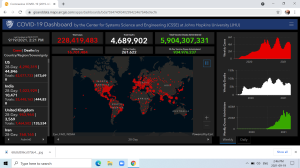
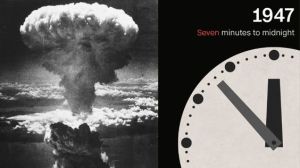
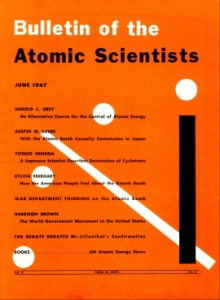
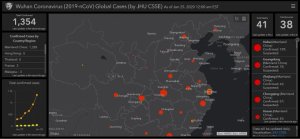
 While some 675,000 Americans died over three years between January 1918 and December 1920 during the three waves of the Spanish Flu pandemic, the country’s population was 103.2 million. Today, the population of the United States is more than 331 million. The world population in 1918 was about 1.8 billion, compared to about 7.8 billion people today.
While some 675,000 Americans died over three years between January 1918 and December 1920 during the three waves of the Spanish Flu pandemic, the country’s population was 103.2 million. Today, the population of the United States is more than 331 million. The world population in 1918 was about 1.8 billion, compared to about 7.8 billion people today.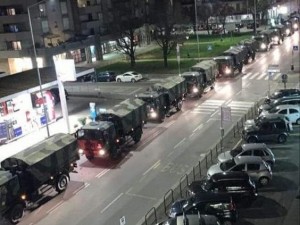
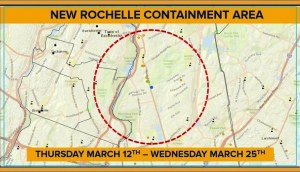
 The rolling real time daily death count on the online COVID-19 Dashboard by the Center for Systems Science and Engineering (CSSE) at Johns Hopkins University (JHU) in Baltimore functions as our equivalent of the Bulletin of the Atomic Scientists’ “Doomsday Clock,” circa 1947, and the clock itself, set at 100 seconds before midnight last Jan. 27, is being profoundly influenced by COVID-19.
The rolling real time daily death count on the online COVID-19 Dashboard by the Center for Systems Science and Engineering (CSSE) at Johns Hopkins University (JHU) in Baltimore functions as our equivalent of the Bulletin of the Atomic Scientists’ “Doomsday Clock,” circa 1947, and the clock itself, set at 100 seconds before midnight last Jan. 27, is being profoundly influenced by COVID-19.







